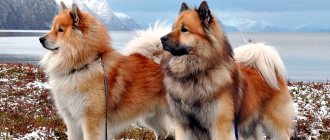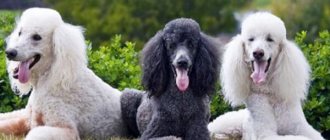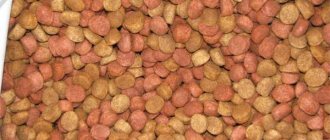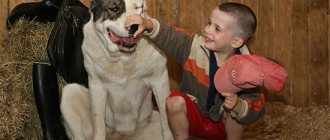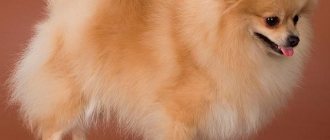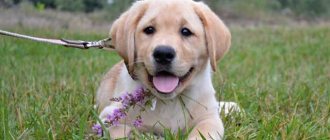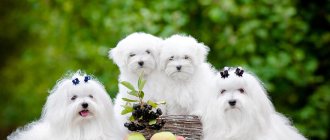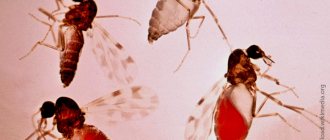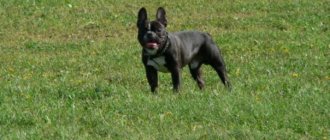Historical reports
The predecessor of this breed appeared on the island of Newfoundland in the early 19th century. There he was nicknamed the “sea dog” for his speed of movements in the water. Local fishermen used her help in fishing. Some believe that this dog was used as a shipwreck sniffer to rescue people from shipwrecks.
One way or another, people liked these dogs, and they began to be exported to England, and already in 1835 the first kennel appeared.
Already there, after crossing the imported “water dogs” and the curly-haired Labrador, the well-known Labrador Retriever appeared. This breed was bred to help people in hunting, fishing and for other needs.
There is a version that Labradors got their name thanks to their Portuguese nickname of the same name, which is translated from their language as “hard worker,” which fully justifies the inherent efficiency of this breed.
- The 20-30s of the 20th century were characterized by a sharp jump in the popularity of Labradors. For their achievements at exhibitions and competitions, the 20th century is called the “Golden Age of Labrador.”
- In 1916, the first club of Labrador lovers appeared, which to this day breeds dogs with the best qualities.
- In the 70s, the exhibition and companion role of the Labrador increased.
- In 1991, this breed became the most popular in America, and its representatives proudly retain first place.
Appearance
Head and neck:
- The wide skull and lack of fleshy cheeks make the head powerful;
- The transition from forehead to muzzle is well defined;
- Correct bite, teeth are of medium size;
- Hazel eyes;
- The ears are mobile, set behind the head, usually take a hanging position, easily change it due to the absence of strong gravity;
- The neck is strong and strong.
Body and tail:
- Smooth back line;
- Wide chest with compressed ribs;
- The tail should not curl over the back; resembles an otter's tail; has a thick coat of fur.
Limbs:
- Straight line of the forelimbs, development of the hind limbs;
- The feet are round and compact, with webbed toes and pronounced pads.
Wool:
- Thick short six;
- The undercoat is waterproof.
Breed standard
The Labrador dog is a large dog. Bitches are slightly shorter than males. Their height at the withers is 53-55 cm, and at the withers - 57-60 cm. These are very massive animals, weighing about 35 kg. The dog's muscles are very well developed. Outwardly, he gives the impression of being hardy and strong, but in reality he is. The retriever's physique is powerful and proportional.
The body is oblong and has the shape of a square. The abdomen is not sunken, the ribs are not visible. The front part of the abdomen is lowered down, that is, there is a dewlap. The back is straight, the lower back is visible. The hind legs are inclined relative to the body, they are slightly longer than the front ones.
The tail is long, densely covered with dense hair. When the dog is alert, its tail straightens into a line and stands parallel to the ground. The chest is powerful and wide. The neck is short. The head is square in shape and wide in volume. The withers are well defined.
Retriever's large, long ears are set back. The eyes are oval-shaped, the iris is brown or black. The nose is dark and large. There are thick folds of skin above the eyes. Eyelashes are black and long. The retriever's jaw is massive, equipped with a full set of snow-white, strong teeth.
According to the standard, the dog should have thick black gums. They are visible even with the mouth closed. The Labrador in the photo looks sweet, kind and charming. This is exactly how nature created him. The dog's appearance fully corresponds to his character.
Now about the fur. It is dense and dense in the animal. The undercoat is abundant and well developed. Thanks to this, the dog almost never freezes in the cold. She inherited her “coat” of dense wool and undercoat from her Newfoundland ancestors. It has the unique property of not getting wet in water. This is why the animal feels comfortable while swimming.
Height and color
Labrador growth standards are 56-57 cm for a male, 54-56 cm for a female. American standards have minor differences: 57-62 cm for a male, 55-59 cm for a female.
The most common color is black. Actually, it all started with black Labradors. Classic, this color looks great, shimmering like black satin. The color may include a small light spot on the chest.
One day, from two black parents, a puppy was born whose color was called field. Now it has several shades: from cream to reddish. In terms of physical and mental qualities, such dogs are not inferior to black ones.
Recommended reading:
Asian Shepherd: description of the breed, character, care and education
Another color is chocolate, and it appeared earlier than the field color. In this case, spots of a different color should not be on the coat. The color became popular after Clinton brought a brown Labrador into his family.
Breed varieties
These wonderful dogs can be divided according to a number of criteria - by color, for example. They can be:
- Sand (the most common color).
- Pure black.
- Chocolate.
- Beige.
- Golden.
- Light brown.
In each variant, a light mark on the sternum is acceptable. Representatives of the breed are also divided into long-haired and short-haired. Popular varieties of Labradors:
1. Retriever. The largest representative of this breed. It is distinguished by its massiveness, playful look and powerful physique. A very kind and cheerful dog, an ideal short-haired pet.
2. Curly-coated retriever. A very rare species. The appearance of such a dog is very similar to the appearance of a small sheep. Her fur curls all over her body.
3. Flat-Coated Retriever. The animal has short fur on its back, head and legs, and long fur on its neck, belly and tail. It is straight and shiny on all parts of the body.
4. Golden Retriever. A very beautiful representative of the breed. Its fur is a bright sandy color reminiscent of gold. It is an excellent swimmer and has an excellent sense of smell, which is why it is often used by the Ministry of Emergency Situations for rescue operations.
5. Nova Scotia Retriever. The second name of the dog is toller. The smallest representative of the breed and the most reserved in terms of emotions. It is distinguished by loyalty to its owner and distrust of others.
6. Chesapeake Bay. A short-haired dog with a distrustful attitude towards strangers. Very faithful.
Character and training
The following can be said about character flaws:
- Excessive mobility, including the tail. A Labrador may accidentally break things with it.
- A strong love of water, which often leads to turning on the taps or a craving for dirty ponds, puddles, etc.
The Labrador retriever has several times more advantages than disadvantages:
- Gets along well with children and older people;
- Enjoys work and activity;
- A real bloodhound. Searching is his favorite pastime;
- We train well;
- Deliberation and dexterity of actions;
- Multi-purpose breed;
- Cheerfulness and optimism;
- Compatible with different breeds.
Labradors are highly trainable, but, as with any breed, you need to identify some training features and even prohibitions:
- During training, you need to use incentive methods. Physical force and other methods of punishment are inappropriate when used with Labradors. The maximum that can be allowed is a change of tone.
- It is easier for a Labrador to learn commands in the form of a game.
- The owner himself should like what he does. If the Labrador sees this, he will want to help, which means he will learn better.
- It is not possible to teach a Labrador to bark for warning or defense purposes. This breed is friendly and outgoing, and uses its voice almost exclusively to express joy.
- Training can begin when the Labrador reaches 4 months. You need to start with the simplest commands regarding the name and other basic things.
- It is better to carry out training in crowded places or in a special group, so the Labrador will learn not only to follow commands, but also not to be distracted by other people and processes around him.
- Labradors can begin training even as a mature dog.
- The intensity and duration of training at first should not exceed 15 minutes; as you grow older, this figure can be increased to 60 minutes.
- With a Labrador, the lessons learned need to be repeated as often as possible so that he understands that this is not just another game, but a serious matter.
- Under no circumstances should you use the gesture of swinging at an animal, this can develop fearfulness in it with such a movement of the hands of absolutely all people.
- Gesture commands are well absorbed by Labradors, but they must be produced clearly and in conjunction with the oral form.
- The Labrador should not be tense during exercise. Such emotional stress affects the allotted life of a Labrador.
Maintenance and care
Place where Labrador will live:
- A place to sleep should be chosen based on two factors: temperature and tranquility. Away from radiators and windows, a secluded space is ideal for a Labrador. To provide additional safety from drafts, it is useful to arrange a bed that is 20 cm higher than the floor surface.
- If we talk about the place of the toilet, then the Labrador is constant in this matter. Where he went to the toilet for the first time, he will continue to go there after. Therefore, you only need to be on the safe side once and reward the puppy after the first time.
Recommended reading:
TOP 10 smartest dog breeds
Things to do:
- Everyone faces the problem of torn curtains and chewed furniture, you say. In fact, this is not true. To avoid this, you just need to give the puppy things specifically designed to be slowly destroyed. The main thing is that there should be no metal parts on toys. You should not play tug of war with your Labrador. This can ruin the ideal bite given by nature. Do not let your puppy crawl under sofas and chairs - it is bad for the spine.
- To reduce activity at home, you need to take your Labrador for walks more often. But the dog doesn’t need exhaustion either. You can go for a run with your four-legged friend or climb a mountain. But if you see that the Labrador is tired, then you see him home - do not make the animal feel tired. If your goal is training, then the load should be increased gradually.
Feeding:
- It is better to give preference to dog food. They have already calculated for you all the necessary elements and vitamins, and in what quantities your pet needs them. But you need to choose only high-quality food recommended by dog breeders and experts.
- For those who prefer natural food, we can recommend homemade cottage cheese, meat, sea fish (exclude fatty fish and pollock), crackers, buckwheat and rice cereals.
- Puppies need to be fed more often, and there is more fat, carbohydrates and meat per pound of weight. In the first two months, the puppy is fed 5 times, with the next two months the number of feedings per day decreases by one. An adult Labrador should be fed twice: morning and evening. Don't forget about water.
- The bowl should be located just above your elbows and made of stainless steel. This arrangement will maintain correct posture for your pet.
Essentials:
- Although Labrador Retrievers are rarely bathed, shampoo and a coat brush are necessary.
- Collar and muzzle. Labrador is a very active dog. She may not wish harm, but still attack the person she likes. So the Labrador needs these attributes, although their protective functions may not be useful.
Nutrition
The basis of the diet of an adult representative of the breed is food rich in amino acids, complex carbohydrates and proteins. Such substances are present in cereals, meat and dairy products. a Labrador puppy should receive microelements contained in fruits, as well as vitamins found in vegetables. He will gain weight gradually. Let's consider a daily menu option for a baby retriever:
- Boiled cow's milk + 100 grams of raw chicken.
- Buckwheat with milk or cottage cheese.
- Boiled or steamed vegetables, such as peppers, broccoli and carrots.
- 100 grams of raw meat.
- Fruits, for example banana.
Cereals can be replaced with soup or broth. Gradually, the amount of food for the dog needs to be increased. This is required for the gradual growth of bones and muscles. An adult representative of the breed can be switched to premium dry food.
Their use of this product has a number of advantages. Firstly, the animal that consumes it will definitely be well-fed and healthy. Secondly, you won't have to cook for it often (trust me, you'll save a lot of time).
In addition, do not forget to treat your dog with berries. She really loves melon, watermelon or raspberries. Never give her spicy fish or chicken bones! They can get stuck in the animal's throat and even lead to its death. Also limit his consumption of processed meats, fatty and fried foods, and smoked foods.
Health and life expectancy
With proper care, Labradors live 10-14 years.
Health problems and prevention:
- Many diseases in Labradors are hereditary. You should ask breeders about the health status of the puppy's parents.
- Dysplasia is a defect in the hip joint. To avoid this defect, you need to closely monitor the puppy. Until the age of 6 months, he should not be exposed to physical exertion and should not move up the stairs independently.
- Diabetes and obesity. Everything here is actually simple - proper nutrition and balanced exercise. To check whether you have overfed your Labrador or not, feel the ribs. They should not be visible, but should be felt.
- Allergy. The main cause of attacks is food, chicken being the most allergic. For prevention purposes, you can use a 1-3 week course of enterosgel. You need to make sure that the Labrador eats, and do not allow your friends to treat him with anything. Self-medication is not suitable in this situation. You need to go to the vet immediately.
It is necessary to be vaccinated against canine distemper, infectious hepatitis, rabies, parvovirus enteritis, parainfluenza, leptospirosis.
Reviews
- Marina. If you treat your Labrador correctly, there will be no end to the joyful emotions! Of course, if you don't keep the animal busy, it can cause mischief. So it was with my beauty. But she got along well with my little son and tolerates all his squeezing. If it weren't for the fur during shedding, it would be completely fine. But these are small things compared to all the good things that our Labrador brought me.
- Stepan. For me, the Labrador has become my best friend. He doesn’t get very tired when we walk, but he doesn’t rush to go outside when we haven’t spent enough time outdoors. He understands everything I tell him; the main thing for him is to be with his owner. It’s worth getting a Labrador – this is a very worthy and kind breed.
- Alyona. The dog, of course, is very kind and smart, but he chewed everything he could in the house, even children’s toys. We played football, were touched by this “little” puppy with the whole family, but still returned it. My daughter was overwhelmed and it was difficult to feed the Labrador. Maybe after some time I will be able to accept such a friend, but not now.
- Ivan. They didn't take a puppy, but a teenager. It was very difficult. There was a feeling that this dog had suicidal tendencies. Then he takes everything in a row, often eats it all. Crashes into objects and people. I finally achieved my goal. He died during an operation - they wanted to get another eaten trophy out of his stomach.
- Arseny. We bought it when I was pregnant. They thought that Labradors were obedient from birth. It turned out that everything is not so simple. Anything could happen, but what unsettled me was the very frequent trips to the toilet right in the apartment. But, thank God, we managed to cope with this. The child was born, grew up, and now he and the dog are best friends. And this is the most important thing. We were not mistaken: the Labrador is the best friend of the family.
Recommended reading:
Australian Shepherd: description of the breed, origin, care and education
Labrador - puppy Labrador - dog Labrador breed Dog breed Labrador Labrador breed
How to properly care for a Labrador puppy?
It must be taken into account that during the first year of life the pet behaves very actively. He will not lie down all the time, so the owner will have to create safe conditions for the Labrador to live in the apartment.
Along with carpeting, you will need to remove fragile and dangerous objects - the puppy may drop, break or stain something while playing.
Dogs of this breed change by about one and a half to two years. Proper training and education of Labradors will help the owner better control the pet's hyperactivity.
The decision to own a Labrador should be closely related to responsibility and the understanding that at a young age he will require special attention and will be very bored alone.
